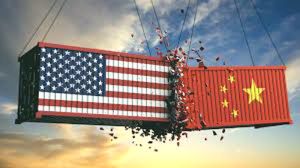export,
trade war
US-China trade war enters new phase
President Donald Trump on Monday effectively broadsided one of the world's largest trade relationships, announcing plans to proceed with tariffs on another $200 billion in US imports of Chinese goods.
 Taken with the $50 billion in tariffs already in place, this means roughly half of everything Americans buy from China — their largest source for imports — is now subject to punitive import duties.
Taken with the $50 billion in tariffs already in place, this means roughly half of everything Americans buy from China — their largest source for imports — is now subject to punitive import duties.
Whole industrial sectors stand to feel the effects, including agriculture, manufacturing, textiles and retail.
Meanwhile, China, which is America's third-largest export market, has vowed to counter-attack with plans to slap tariffs on another $ 60 billion in US exports, meaning about 80 percent of US exports to China would be subject to retaliation.
Here is a rundown of some of the products in question.
Half of Chinese exports
The Trump administration says its aggressive stance is to pressure Beijing to change policies that allow for the theft of US technology and undercut American producers.
Trump started out in July and August with a more modest $50 billion round of tariffs targeting aircraft parts, computer hard drives, machinery and appliances, optical and surgical equipment as well as autos — goods Washington said had benefited from unfair trade practices.
But Monday's announcement moves things up by an order of magnitude. According to a preliminary list released in July, the administration is now targeting $8.4 billion in plastics, $64.8 billion in electrical machinery, $55.1 billion in appliances and $25.8 billion in furniture as well as broad ranges of seafood and meat.
Other items that have been on the US target list since the summer include milking machines for dairy cows, incubators for baby chicks, flight data recorders, x-ray tubes, bulldozers and arc lamps as well as motorcycles and mopeds.
China hits back
Chinese imports from the United States grew by nearly 500 percent over the past five years, such that as of 2017 Chinese buyers accounted for almost one in every five dollars in US export revenue.
Beijing has since accused the United States of starting the «largest trade war in economic history.» In retaliating, China in July announced tariffs on American agricultural goods and autos. Also in Beijing's crosshairs are exports like hybrid electric and off-road vehicles, coal, dump trucks, asphalt, MRI machines and motorcycles, among other items.
Harley-Davidson will have to bump up the Chinese price of its iconic motorbikes at least 20 percent, a store representative in Beijing said. That adds to the American beef, pork, many types of fish, and dozens of fruits and nuts that were taxed in July.
The most painful perhaps is the tariff on US soybeans, which chokes off a key export market for American farmers, who shipped $14 billion of the beans to China last year.
If China then slaps tariffs on another $60 billion in US goods, this will bring total US exports subject to Beijing's retaliation to $110 billion, at 2017 sales levels.
Where Washington pulled its punches
With 50 days to go before crucial mid-term elections and many in Trump's own Republican party are queasy about Trump's trade wars, which have drawn loud objections from senior figures within the party.
American officials said Monday they were conscious of the need for American businesses to find alternate suppliers before the tariffs hit.
«If the tariffs go to 25 percent at the beginning of the year, you will have had almost six months to get your business ready for that,» a senior administration official told reporters on Monday.
In a further attempt to cushion the blow, Washington canceled plans to put tariffs on about 300 product categories, including hot consumer items like smart watches and Bluetooth-enabled devices, chemicals for manufacturing, agriculture and textiles, as well as bicycle helmets, and children's high chairs, car seats and play pens.
